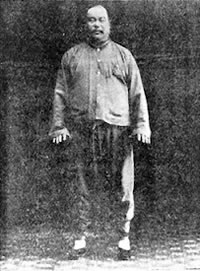Many Tai Chi Masters promote the importance of standing. At first, I was not so convinced. Standing simply seemed boring to me. Then I attended a few workshops where standing was the main focus. I began practicing. The more I practice standing, the more interesting it became. I noticed changes in my tai chi practice. Now I have come to realize that standing is absolutely essential to the development and progress of my Tai Chi abilities. You can say I have grown to develop a tremendous appreciation for standing meditation and I would like to share it with you.
Standing meditation brings movement to stillness.
Right after the warm-up exercises and before we practice the form, I always try to incorporate some standing meditation usually in the form of Zhan Zhuang postures. This quiets the mind while opening the meridians and jump starting the internal energy. It allows the student to relax and soften the muscles. After a while, we can feel the energy move as we stand silently still.
Standing meditation helps the Tai Chi practitioner experience Wuji
This piece is specific to the Wuji stance. Throughout the form, we are manifesting different levels and mixtures of yin and yang. Even at the beginning of the first movement in the form, we create opposites out of nothingness (wuji). I have found it best to stand in Wuji for a few minutes to ensure complete absence of yin/yang before starting the movement. During this time we can review the basic tai chi principles like opening the joints and sinking the chi. Eventually we will experience wuji, allowing us to begin the form with the appropriate levels of energy awareness.
What is standing meditation?
There are many ways to meditate while standing and many energy cultivating disciplines that utilize standing postures, such as Zhan Zhuang, Neigong and Wuji. While the specific stance might be different, most standing exercises emphasize (1) Posture, (2) Softness, and (4) Breathing.
Posture
Different energies flow with different postures, however, the postures needs to be correct. Emphasis on the correctness of the posture is key to most standing meditations. Are your knees appropriately bent or straight? Knees should never be locked. Is your head top suspended? Are your elbows creating a nice soft curve? Is your head resting evenly on your shoulders? Is the tip of your tongue touching lightly the roof of your mouth? Think about everything you have learned about your posture, leaving nothing out.
Softness
While exerting just enough energy to maintain the correct posture, all the molecules in your body should rest in a deep state of relaxation. There should be no signs of tension. Are your shoulders relaxed? Are your arms, hands and fingers relaxed? Are your ankles, feet and toes relaxed? Is your face relaxed? Do you have a nice soft gaze with your eyes? Go through your entire body and feel for signs of tension. When you find it, allow the tension to flow down through the limbs and out of the body.
Breathing
Breathing should be deep into the lower abdomen and should not create movement in the chest and shoulders. The breath should be quiet, or as quiet as you can make it. Usually all the breathing is done through the nose, but sometimes the form calls for an exhale through the mouth. When exhaling through the mouth try to make the breath as smooth and quiet as possible.
Thoughts
Some standing meditations include a gentle awareness of the central abdomen, Dantien. Some say only be aware of your posture and comfort level. Others say to empty the mind of thoughts. Don’t take this literally, but rather when a thought comes to your mind, allow it to softly slip away.
Standing meditation compliments and enhances Tai Chi practice
I am convinced that by incorporating standing meditation in your practice, your progress with Tai Chi will accelerate. And as many of us are aware, there seems to be no limits when it comes to Tai Chi.
Dave Pankey




Thank you for concisely explaining this mysterious subject.